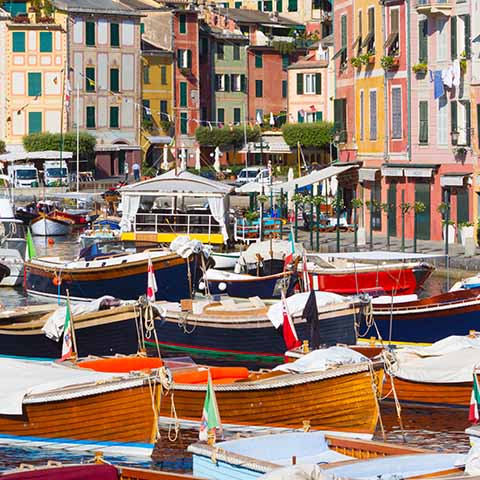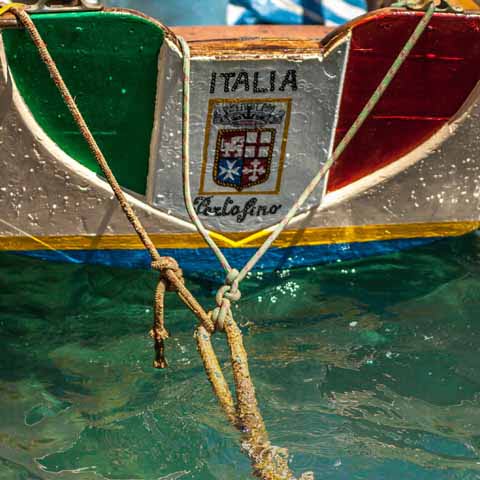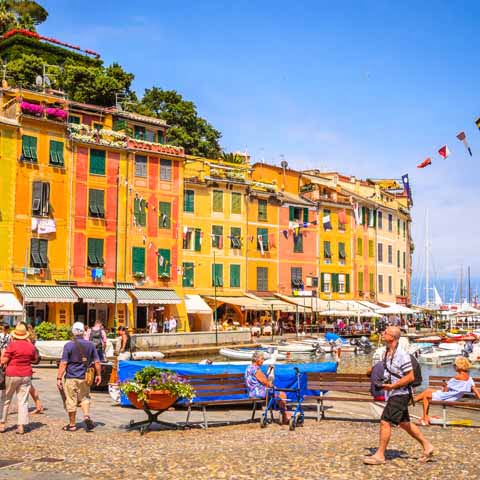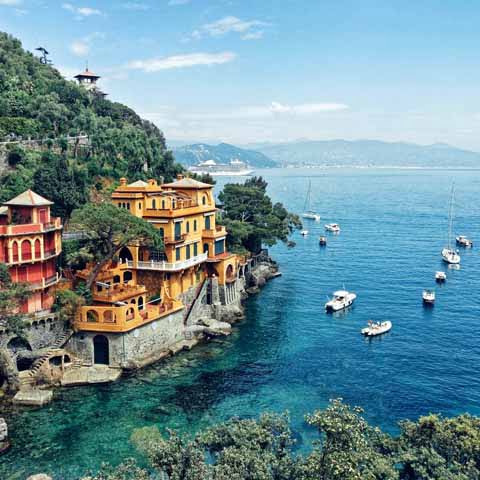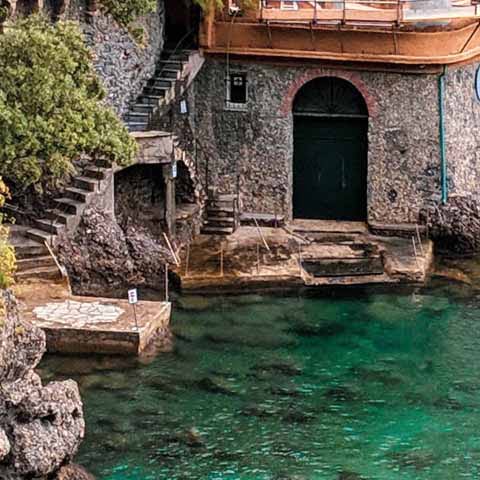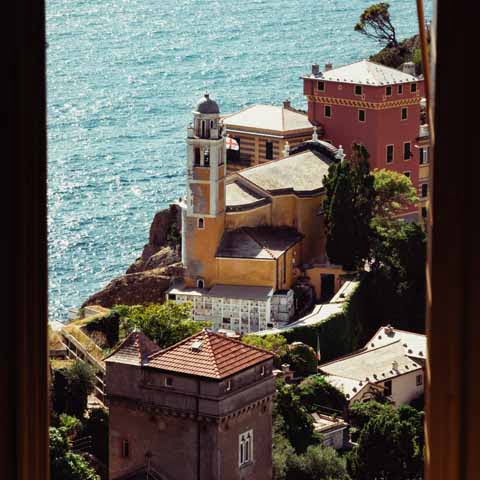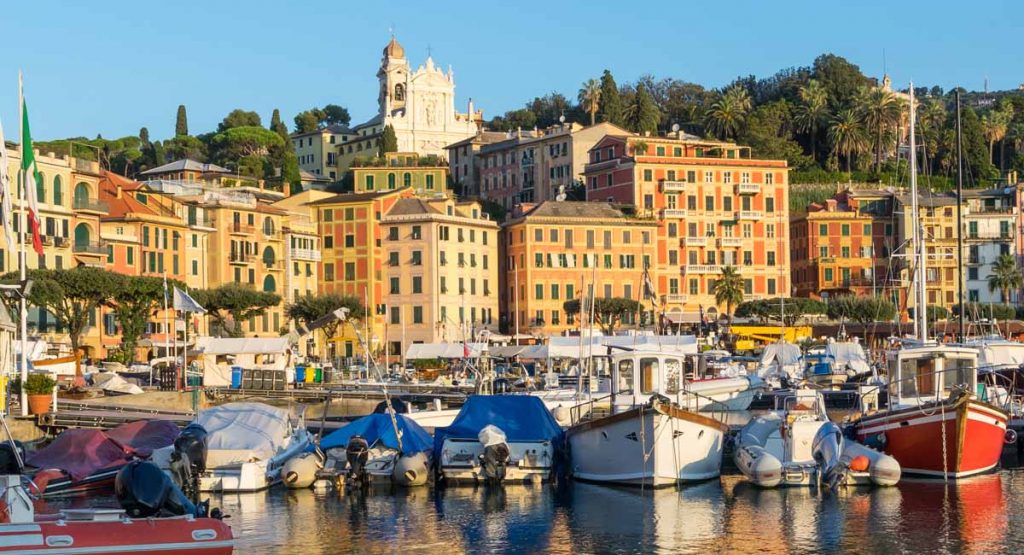Perhaps no other region in Italy’s history has felt the need of constant change the way Liguria has. For the locals, the vastness of the sea corresponds to the narrowness of the land, picturesque but steep and in need of constant renewal.
The difficult environment of the region is reflected in the way settlements developed. And Portofino best represents Liguria’s way of being.
This small settlement is a place that has adapted to the difficult configuration of the terrain, which has challenged inhabitants for centuries.
Portofino is a concentrated area of unique art and history. It also features perfect harmony between nature and human intervention. Enjoy a burst of colors surrounded by hills covered in oak trees and pines of Aleppo overlooking the sea. Notice the stretches of orchards that have made it one of the most beautiful places in the Mediterranean.
As Guy de Maupassant called it, Portofino is a small village that widens like a moon arc around a calm basin. Indeed, a very small municipality, the village impresses with picturesque streets, elegant boutiques, and modest souvenir shops. But what is even more impressive is the long and interesting history that stands behind this peculiar settlement.
Portofino’s ancient origins talk about a strategic position for maritime trade since the earliest times, but there is much more buried in the roots of this charming place.
PREHISTORY OF PORTOFINO
Portofino’s origins are lost in the most remote antiquity. Some believe the settlement has Phoenician origins, while others praise the Greek origins of the first populations. Although a small group of scholars claim that Portofino’s origins are Roman.
It’s hard to agree with any of these theories though. In fact, the birth of Portofino goes back to protohistory. The first civilizations settling in the region were perhaps attracted by the sheltered position, protected against winds and facing the sea.
These geographical factors favored the emergence of the first inhabited nuclei, but the very same factors also contributed to making Portofino remarkable during the centuries.
Evidence shows the Tigullii, an ancient Ligurian tribe, inhabited the entire area of Val Fontanabuona up to the current Gulf of Tigullio and the promontory of Portofino as early as the eighth century BC. This Celtic-Ligurian population dedicated to trade appreciated the strategic position where Portofino would grow thanks to its easy access to the sea.
These early populations thrived in the region until the advent of the Roman Empire, when the strategic position, according to historian Pliny the Elder, caught the attention of Rome.
Local populations had no chance of fighting Roman occupation and succumbed to their reign. Portofino gained the name of Portus Delphini, perhaps due to the large population of dolphins swimming in the waters of the Gulf of Tigullio in the era.
But the Romans did not only see an opportunity for growing their trade and extending their hegemony overseas in Portofino. As Pliny mentions, the settlement was located in a safe place for docking ships, but the enchanted position made Romans consider Portus Delphini a travel destination since the earliest times.
HISTORY OF PORTOFINO
With the Romanization of Liguria, Portofino became a Roman colony, then passed under the jurisdiction of the Holy Roman Empire in the early Middle Ages.
Under the Lombard domination, Portofino became the territory of the Abbey of San Colombano di Bobbio, and the monks gained control over the settlement. With the expansion of monastic power, the village became more and more powerful.
With a letter left by Adelaide of Burgundy, the wife of Lothair II of Italy, in 986, the area of Portofino was donated to the Abbey of San Fruttuoso, a monastic settlement originally located on today’s territory of Camogli.
Under the monastic rule, Portofino entered a period of prosperity and gained an important military role. In 1072, the city successfully fought the assault of the naval fleet of Pisa. The victorious act of the inhabitants did not pass unnoticed and caught the attention of nearby Rapallo, whose consuls succeeded in purchasing Portofino from the abbey for the amount of 70 Genoese lire in 1175.
The small fishermen village became an integral part of the Republic of Genoa in the thirteenth century, together with the entire territory of Rapallo.
This change transformed the settlement into a true refuge of the Genoese merchants thanks to its natural harbor, bringing wealth to the region.
However, stability did not last for long, and in 1409, after the removal of the Emperor Charles VI of France from Genoa, the village was sold to Florence. But Florence had no interest in the region, and after a period of true decay for the municipality, the Florentine Republic returned Portofino to Genoa.
During the rest of the fifteenth century, Portofino underwent several administrative changes and passed under the rules of the most powerful feudal families of the time. Starting with 1425, the village became a possession of the Fregoso family, specifically of Tommaso Campofregoso, the former Doge of the Republic of Genoa and Lord of Sarzana.
Campofregoso subdued Portofino for five years; then the municipality passed under the rule of Francesco Spinola. The lords of the fief administered Portofino for fifteen years, until 1445, when Giovanni Antonio Fieschi subtracted the territory from the Spinola.
This act must have been a pure act of demonstration of power, since Fieschi returned Portofino voluntarily to the Republic of Genoa only four years later.
The village was resumed to the Republic under the rule of Pietro Fregoso, but this domain did not last long either. The beginning of the sixteenth century found Portofino in the middle of struggles for power between the Fregoso, the Fieschi, and the Adorno. But Fieschi and Adorno were supported militarily by Francesco Sforza, the Duke of Milan, and by the Swiss troops.
Fregoso lacked the military power to fight these forces and succumbed the village. Administrative control was entrusted to Filippino Fieschi who was nominated commander of the Portofino fortress, while admiral Andrea Doria was assigned to offer military support.
Nevertheless, Genoa did not just sit and watch, but entrusted the action to 4,000 infantrymen and mercenaries who eventually regained possession of the territory, defeating the valiant men of Doria.
Unwilling to accept the defeat, Doria returned to the waters of Tigullio in 1527 and engaged in a long battle against the dogmatic militia, regaining control of the territory. But Genoa had no intention of leaving their possession to an admiral.
In 1554, relying on the direction of Gian Maria Olgiato, the Republic of Genoa remodeled the defensive system of Portofino, particularly of the fortress of San Giorgio. This did not lead to peace though, and the struggles continued for the rest of the century.
In 1608, Portofino was included once again in Rapallo’s administration, and it stayed until 1797 when the French domination of Napoleon Bonaparte established the return of the municipality to the Department of the Gulf of Tigullio.
The administrative control was still assigned to Rapallo, but Portofino was now part of the Ligurian Republic.
A year later, under the new French orders, Portofino was however returned to the third canton with the capital in Santa Margherita and under the jurisdiction of Tigullio. From 1803, the main center of control was moved once again to the second canton of the Gulf of Tigullio in the jurisdiction of Entella.
Subsequently, Portofino was annexed to the First French Empire and from 1805 to 1814, it passed under the jurisdiction of the Department of the Apennines.
In 1814, the small fishermen village became the scene of bloody battles between the English and Napoleonic troops which were driven out from the castle. The English victory brought new changes to Portofino which was incorporated, together with the whole territory of Genoa, in the Kingdom of Sardinia, according to the decisions of the Congress of Vienna.
From now on, Portofino’s history coincided with the history of Genoa. The municipality became part of the Kingdom of Italy in 1861 and was included in the province of Genoa.
World War I had little impact on Portofino, but the municipality was actively involved in World War II. Particularly in December 1944 when 22 partisans were shot by the Nazi soldiers led by Siegfried Engel in the nearby locality of Olivetta.
Following the war, Portofino regained its paced lifestyle and slowly transformed from a quiet fishermen village into an international travel destination. With its natural beauty and enchanting architecture, Portofino brought fame to the entire Tigullio coast, earning the region the nickname of the “Pearl of the World.”
ARCHAEOLOGY IN PORTOFINO
Archaeology is well represented in Portofino and the surrounding areas, especially in Camogli, a municipality located less than ten miles from Portofino. Evidence in the area testifies the human presence in the territory since the earliest times.
Among the most attractive archaeological evidence present in the territory is the Castellaro, a fortified prehistoric settlement built in a strategic position. This type of fortress served as a military structure and had a defensive role.
According to this structure, the presence of man on the promontory of Portofino is dated as early as the end of the middle bronze age, in the sixteenth century BC. Furthermore, excavations carried out in 1969 and the subsequent years near the Castellaro have highlighted the existence of another small settlement consisting of oval huts built on dry stone walls as a way to overcome the roughness of the steep terrain.
Tools and numerous other artifacts brought to light in the same site bring further evidence of the main occupation of the earliest populations, which were mainly dedicated to agriculture, breeding, and hunting.
Among the finds, there were also many ceramic fragments, parts of hunting tools, bone remains from various animals, and other artifacts which serve as evidence of the rise of a prolific early civilization.
Unfortunately, public access is prohibited in the entire area of Castellaro, but many artifacts dated between 2000 and 1200 BC are exhibited in the archaeological museum in Camogli.
But archaeological evidence is not centered around Castellaro alone. In the crystalline waters surrounding the coast, at the south of Portofino, two amazing amphorae dated between the second and first century BC have been found.
Undoubtedly the legacy of the Roman Empire is now exhibited in the Museum of the Sea in Santa Margherita Ligure, near Portofino.
Those who like diving can also enjoy the wreck of Croesus sunk in 1855, that of Mohawk Deer, a steamship sunk in the second half of the twentieth century, and the wreck of Schooner from the first half of the twentieth century.
Indoor places include the Archaeological Museum of Camogli which includes an extensive collection of artifacts and numismatics, including a cisalpine coin used as currency in the earliest times.
Besides archaeology, the Museum of Fishing and the Museum of Sailing present the history of Portofino and its territory from the perspective of its inhabitants, who were involved in fishing and maritime trade since prehistory.
An absolutely unique place closely related to the history of Portofino is also the abbey of San Fruttuoso. This Benedictine monastery is still a place where humans and nature are perfectly integrated with one another. During the centuries, the edifice also served as a pirate’s nest and a humble fisherman’s house and is truly worth visiting.
Travel Guides
The Liguria Region Of Italy
The Cities Of Liguria
